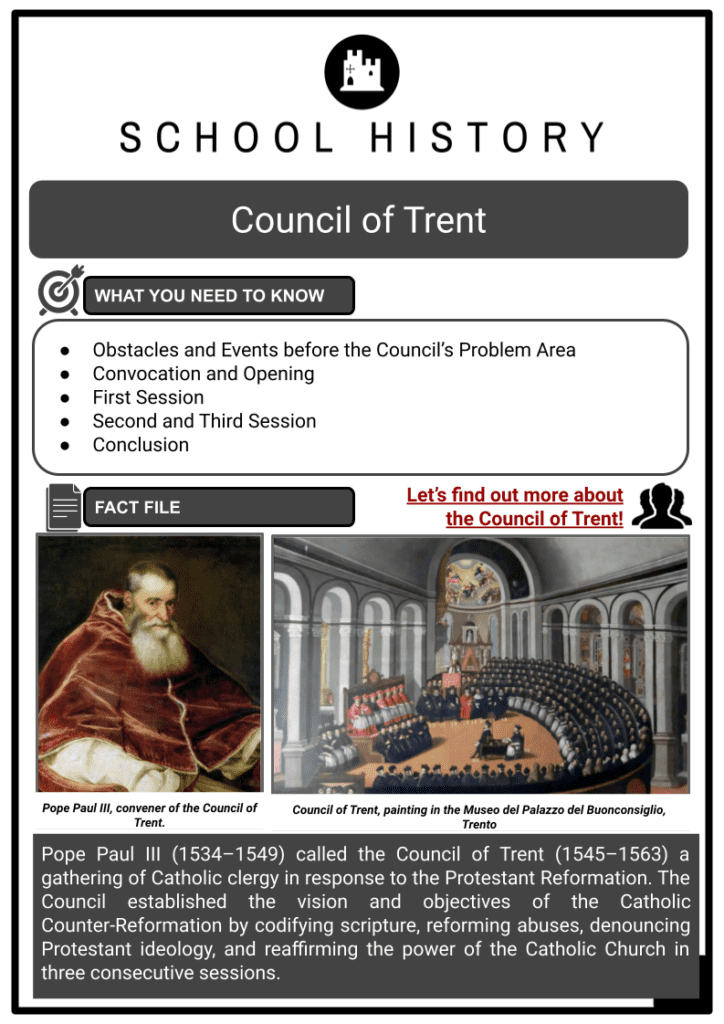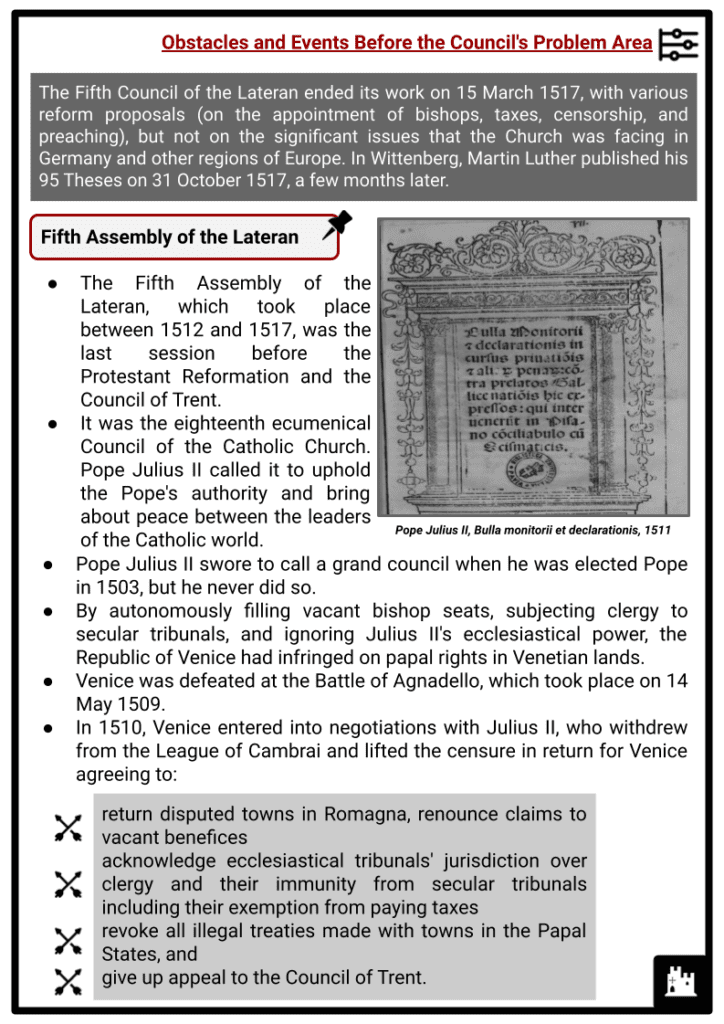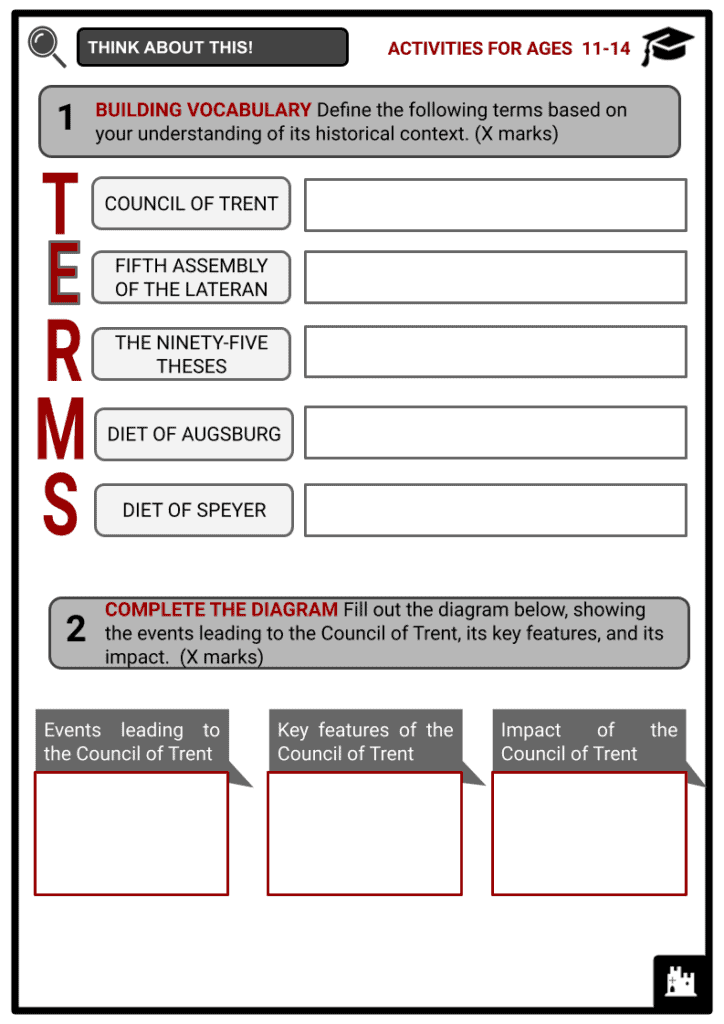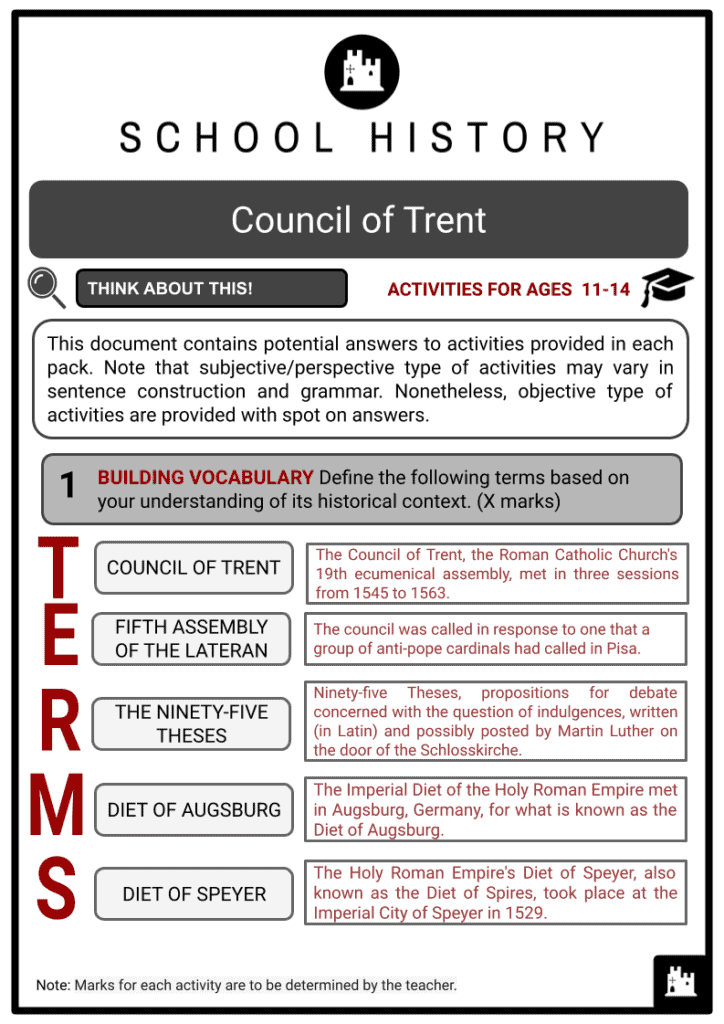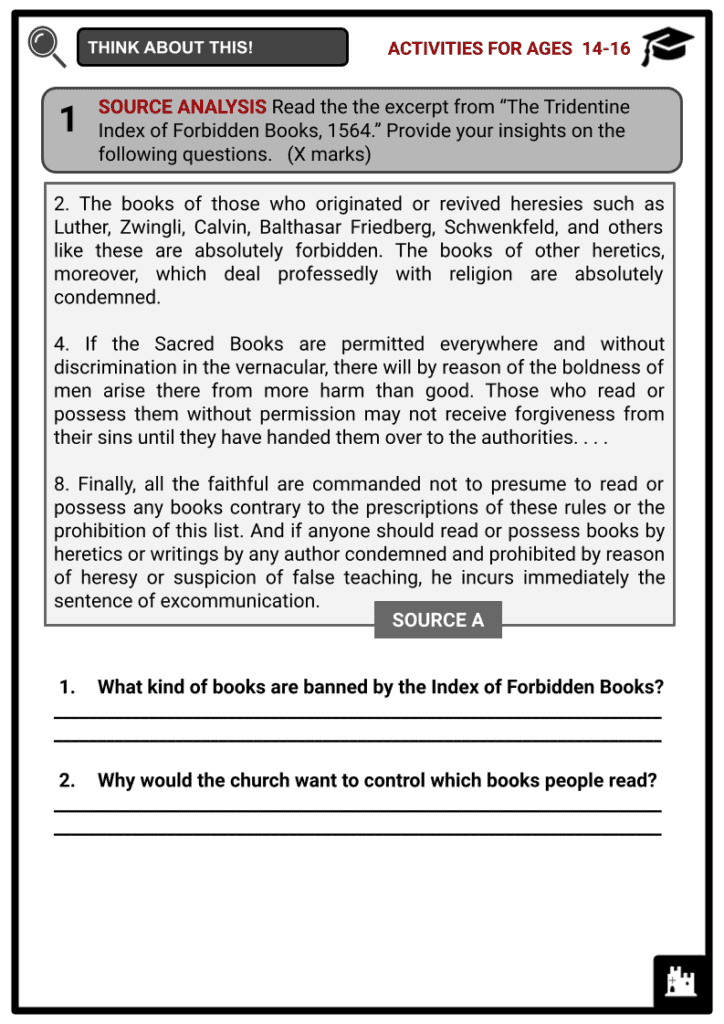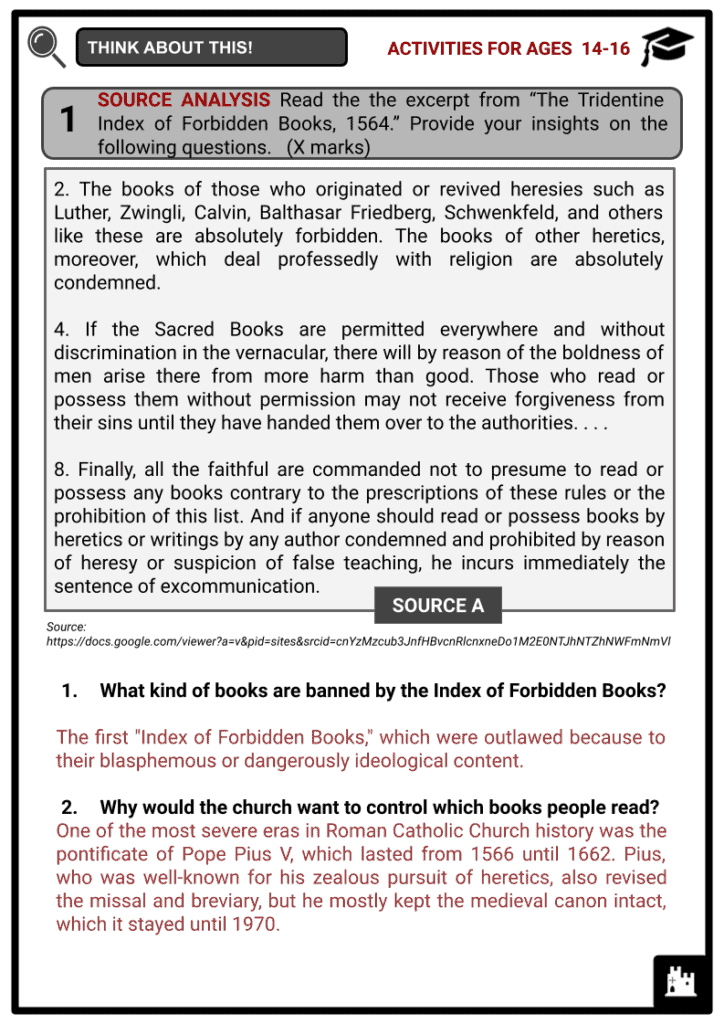Council of Trent Worksheets
Do you want to save dozens of hours in time? Get your evenings and weekends back? Be able to teach about the Council of Trent to your students?
Our worksheet bundle includes a fact file and printable worksheets and student activities. Perfect for both the classroom and homeschooling!
Summary
- Obstacles and Events before the Council’s Problem Area
- Convocation and Opening
- First Session
- Second and Third Session
- Conclusion
Key Facts And Information
Let’s find out more about the Council of Trent!
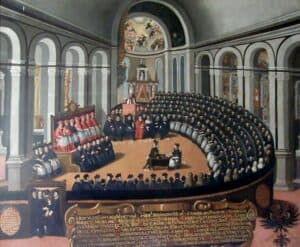
Pope Paul III (1534–1549) called the Council of Trent (1545–1563) a gathering of Catholic clergy in response to the Protestant Reformation. The Council established the vision and objectives of the Catholic Counter-Reformation by codifying scripture, reforming abuses, denouncing Protestant ideology, and reaffirming the power of the Catholic Church in three consecutive sessions.
Obstacles and Events Before the Council's Problem Area
- The Fifth Council of the Lateran ended its work on 15 March 1517, with various reform proposals (on the appointment of bishops, taxes, censorship, and preaching), but not on the significant issues that the Church was facing in Germany and other regions of Europe. In Wittenberg, Martin Luther published his 95 Theses on 31 October 1517, a few months later.
Fifth Assembly of the Lateran
- The Fifth Assembly of the Lateran, which took place between 1512 and 1517, was the last session before the Protestant Reformation and the Council of Trent.
- It was the eighteenth ecumenical Council of the Catholic Church. Pope Julius II called it to uphold the Pope's authority and bring about peace between the leaders of the Catholic world.
- Pope Julius II swore to call a grand council when he was elected Pope in 1503, but he never did so.
- By autonomously filling vacant bishop seats, subjecting clergy to secular tribunals, and ignoring Julius II's ecclesiastical power, the Republic of Venice had infringed on papal rights in Venetian lands.
- Venice was defeated at the Battle of Agnadello, which took place on 14 May 1509.
- In 1510, Venice entered into negotiations with Julius II, who withdrew from the League of Cambrai and lifted the censure in return for Venice agreeing to:
- return disputed towns in Romagna, renounce claims to vacant benefices
- acknowledge ecclesiastical tribunals' jurisdiction over clergy and their immunity from secular tribunals including their exemption from paying taxes
- revoke all illegal treaties made with towns in the Papal States, and
- give up appeal to the Council of Trent.
The Ninety-Five Theses
- On the other hand, Martin Luther, a professor of moral theology at Wittenberg University in Germany, which was then governed by the Electorate of Saxony, drafted the “The Ninety-Five Theses” or “Disputation on the Power and Efficacy of Indulgences” in 1517 as a set of arguments for a scholarly debate.
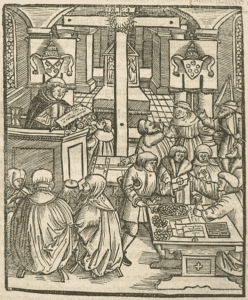
Woodcut of an indulgence-seller in a church from a 1521 pamphlet - This paper advances Luther's arguments against what he saw as clergy abusing the practice of selling plenary indulgences, which were documents believed to alleviate the purchasers' or their loved ones' temporal suffering in purgatory for sins committed.
- In retrospect, these indulgences are considered to have marked the beginning of Protestantism.
- In his Theses, Luther claimed that Christ demanded genuine repentance for sins to be forgiven instead of merely external sacramental confession.
- He contended that Christians who received indulgences avoided genuine remorse and sorrow for sin because they thought they could avoid it by receiving an indulgence.
- Luther claimed that these indulgences led Christians away from charitable donations and other deeds of kindness because they thought the certificates were more spiritually significant (even though indulgences were granted for such actions).
- The Theses contest a papal bull from the 14th century that said the Pope could use the treasury of merit and the good acts of former saints to absolve temporal penalty for crimes, notwithstanding Luther's claims that his views on indulgences agreed with the Pope's.
- Luther eventually clarified his thoughts in the Explanations of the Disputation Concerning the Value of Indulgences.
- However, the Theses are presented as arguments to be made in dispute rather than necessarily representing Luther's opinions.
Convocation and Opening
- Because he thought he would be sentenced to Rome for his heretical views, Luther petitioned a grand council from the Pope on 28 November 1518. In 1523, the Diet in Nuremberg demanded the establishment of a "free Christian council" on German soil.
- In 1524, the same city hosted the next Diet, which called for establishing a German national council to arbitrate disputes temporarily and a general council to resolve claims against Rome and religious conflicts definitively.
- The demand was hazardous because of the sentiment that spreaded in Germany. Rome did not actively object to having a general council, but it categorically rejected the German National Council.
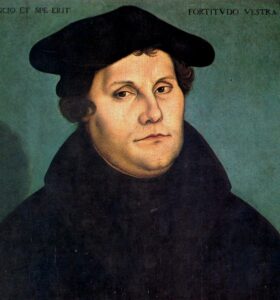
A painting of Martin Luther (1529) by Lucas Cranach the Elder - Rome did not vehemently object to having a general council, but it categorically rejected the German National Council.
- Although Charles V oppose the national Council, he informed Clement VII through his ambassadors that he thought convening a general council was a good idea and suggested Trent as the location.
- The terrible conflict between the emperor and Pope prohibited any further discussions for a council in the years immediately after this.
- Nothing was done until Pico Della Mirandola, the papal envoy, announced in 1529 at the Diet of Speyer that the Pope was prepared to support the Germans in their war against the Turks, to call for the restoration of peace among Christian kings, and to call a general council to convene the following summer.
- At their meeting in Bologna in 1530, Clement VII promised to convene a council if necessary. Lorenzo Campeggio, the cardinal legate, opposed calling a council because he believed that the Protestants were being dishonest in their demand.
- Nevertheless, the Catholic rulers of Germany, particularly the dukes of Bavaria, supported a council as the best strategy for resolving the Church's problems.
- In order to take action against the Turks, whose troops were advancing in Hungary and would eventually besiege Vienna, as well as against the continued advancement of Protestantism, the Diet of Speyer was called in March 1529.
- Charles was adamant about holding the Council as soon as there was a time of widespread calm throughout Christendom.
- The issue was also raised during the Diet of Augsburg in 1530, where Campeggio once more opposed a council while the emperor announced himself in favour of one with the condition that the Protestants would agree to reinstate previous conditions until the Council's decision.
- Emperor Charles V called for the Augsburg Imperial Diet in 1530 to make decisions on three matters: first, the Empire's defense against Ottoman threat; second, matters pertaining to policy, currency, and public welfare; and third, disagreements regarding Christianity, in an effort to reach a compromise and a chance to deal with the German situation.
- The Catholic princes agreed with Charles' proposal, although they preferred the gathering to occur in Germany. Due to the emperor's communications to his diplomats in Rome on the subject, the congregation of cardinals designated specifically for German matters met twice to address the issue.
- Despite divergent viewpoints, the Pope wrote to the emperor that Charles might offer to call a council with his approval if the Protestants returned to the Church's obedience.
- He suggested that the meeting occurs in an Italian city, ideally Rome. However, the emperor mistrusted the Pope because he thought Clement was only pretending to want a council. The Protestant princes, meantime, refused to renounce their beliefs. Although Charles and most of the cardinals, particularly Farnese, del Monte, and Canisio, continually encouraged him to summon a council as the only way to resolve the theological disagreements, Clement raised objections to it.
- The Protestant rulers remained steadfast in their stance throughout this time. Francis I of France made unrealistic demands to prevent the Council from being called.
- The most esteemed of the remaining governing princes and the German electors were to be individually informed of the Council's upcoming pronouncement by Vergerio, Ferdinand's nuncio.
- He carried out his duty with zeal despite frequently encountering resistance and mistrust. Rome required that the Council meet in an Italian city.
- Therefore choosing a location for the meeting was highly challenging. The Protestant leaders rejected the proposed Council gathered in Smalkald in December 1535. Kings Henry VIII and Francis I supported them in this.
- At the same time, he continued the double intrigue he had always conducted about German Protestantism by sending assurances to Rome that he thought the Council would be beneficial for eradicating heresy. Charles V and the Pope came to a perfect understanding of the Council due to his travel to Rome in 1536.
- Another attempt at bringing Catholics and Protestants together was undertaken by Pope Paul III and King Charles V in 1537.
- However, due to the military disputes between Charles V and King Francois I, this meeting was never held.
- In addition to the turbulence and violence that followed the Reformation, Charles V was still eager to bring about some peace because he needed his people to stand as one against a potential Ottoman invasion.
- The subsequent attempt was planned for 13 December in Trento (now Trent), Northern Italy.
First Session
- Even though it was billed as an ecumenical conference, the Catholic delegation prevented Protestants from participating meaningfully in the proceedings or voting from the start. Protestant clergy responded by declining participation (even though some, like Melanchthon, made initial attempts). The Council of Trent thus evolved into a Catholic gathering whose objectives were to correct Church abuses (such as the indulgence trade), respond to criticisms of Church doctrine and practice, and assert (or reaffirm) the Church's dominance over society.
- Suppose the Church had merely considered Luther's early objection to the sale of indulgences rather than attempting to quiet him. In that case, the Protestant Reformation might not have occurred or would have grown differently.
- As it happened, though, he continued from that criticism to an outright rejection of the Church. His main contention was that one was justified before God by faith alone and that all one required for communion with God was the Bible.
- The Church asserted that one was justified by their actions owed from their faith, citing verses like I Corinthians 15:58 from the Bible, which says, "Abound in every good work, knowing that your labour is not in vain in the Lord."
- For example, Luther quote the verse, in his response to the question (Ephesians 2:8-9). "For by grace you have been saved, through faith; and this is not of yourselves, it is the gift of God, not of works, lest any man should boast"
- Therefore, the topic covered was how one was made righteous in God's eyes.
- However, before they could answer that question fully, they had to agree on which books of the Bible were Holy Scripture.
- An "authoritative" version of the Bible had to be chosen to offset the Lutherans' rejection of some texts and Luther's publication of his translation of the Bible at this point.
- When the Vulgate translation of Saint Jerome was confirmed as the sole authoritative text, this ended in April 1546. By June 1546, they had all come to the same conclusion that original sin does divide the soul from God and necessitate the need for justification.
- After months of discussion, they came to their views on justification in January 1547. The Council also endorsed the spiritual necessity of child baptism in March 1547, rejecting the Anabaptists' argument that only adult baptism was acceptable, as well as the significance of and practices surrounding confirmation in the Church.
- The disease prevented further sessions from taking place, and even though there were still meetings, no other decrees were made until the Council was prorogued in September 1549.
Decrees & Canons of First Session
- While rejecting and condemning Protestant claims, the session issued a series of decrees (edicts) and canons (rules or regulations) that confirmed Church doctrine and practice.
- It also upheld and authorised Pope Paul III's institution of the Holy Office, now known as the Inquisition, in 1542.
- The decrees mainly concentrated on justification and how the Church's teachings provide the necessary spiritual direction for the soul to obtain eternal life in heaven.
- Protestant deeds led one astray and would ultimately send the soul to hell after death. The canons followed this same pattern but were a deliberate and explicit rejection of Protestant theology, criticisms, and practice.
- The other decrees also dealt with justification either directly or indirectly. The last words of every canon are:"Let him be anathema" which means "excommunicated from the Church"and "destined for damnation".
- They principally aim at the Lutheran doctrine that says salvation comes by faith and scripture alone.
- The Protestant Reformation was deemed heresy by the canons, and those who supported it were labelled heretics.
- The Church's primary justification (source of authority) was that if anyone could assert that they knew "truth" by merely concluding that what they knew was true, then there was no such thing as truth —only human opinion.
- Furthermore, there would be no "genuine" reading of the Bible if anybody who could read it could interpret it for himself.
- People were thought to be born with a corrupted will and could not rely on their knowledge to interpret the Bible; instead, they were advised to follow ancient beliefs and practices as well as the writings of the Church Fathers.
Second and Third Session
- Under Pope Julius III (reigned 1550–1555), the second session met in May 1551, intending to settle issues about the Eucharist. Some Protestant factions (starting with Zwingli in Switzerland) asserted that the Mass was merely a commemoration of Christ's death and rejected the presence of God at the consecration for the fact that the bread and wine were altered into Christ's flesh and blood.
- In Canon 1 from 1551, the Council declared that this was heresy and that Christ was truly present in the Eucharist, punishing anybody who disagreed.
- They followed a similar course with penance and extreme unction, insisting that these practices were established by Christ himself and could not be rejected without endangering one's soul from eternal damnation.
- When Protestant prince Maurice, Elector of Saxony, a former friend of Charles V in the Schmalkaldic War, led him to side with the French King Henry II in the Second Schmalkaldic War in 1552, the session was supposed to proceed on to other topics but was prorogued.
- The Council met in January 1562 under Pope Pius IV.
- This session focused chiefly on addressing abuses within the Church, such as uneducated clergy who subsisted off parishioners' tithes without offering comfort or spiritual direction.
- To create seminaries and update the qualifications for clergy, decrees were issued.
- Ignatius of Loyola founded the Society of Jesus (Jesuits) in 1534 and, after receiving papal approval, launched an educational project that, by 1562, had gained traction and spread.
- In 1563, the Council approved the development of different seminaries and for clerical candidates to pursue more in-depth study.
- The Council maintained that neither Christ nor his disciples were married in response to the Protestant assertion that clergy might wed and emphasised that Saint Paul had handled the matter in the scriptural verse, "It is good for them to stay unmarried, as I am" (I Corinthians 7:7)."
- The clergy decided to follow Paul's advice and lead by remaining single. The writs would no longer be sold but may be obtained for a donation, and the procedure would be regulated, thus addressing the Protestant objection to the sale of indulgences.
- Protestant opposition to worshipping saints and relics was also criticised, as was their rejection of sacred art and iconography.
- The Catholic Counter-Reformation and the Council of Trent gave rise to the baroque style by approving the commissioning of sacred artwork and musical works to combat the Protestants' iconoclasm (Händel's Messiah is a direct outcome of this).
- Catholic churches would go from simple Protestant halls of worship to becoming grander and more elevating. The architecture, art, and music would all work together to help a worshiper develop a stronger bond with God and the Church.
- Sacred mysteries of faith were to be celebrated. Music, in particular, was to be employed to inspire contemplation of God's majesty and wonder and to open oneself to heavenly joy.
- In parallel, the Index Librorum Prohibitorum (Index of Prohibited Books), published in 1559, was sanctioned by a decree in 1563 that notably included the writings of Reformers, including Luther, Zwingli, John Calvin, and others.
- This was settled to stop the spread of Protestant thought. According to the Index's precise regulations, a Catholic in good standing with the Church was to reject any book denounced by the Pope, the Holy Office, their priest, or their bishop.
- Unrepentant reading of literature included in the Index was viewed as a grave sin and a rebellious act that endangered the soul. The Index was still in use when it was suspended in 1967.
Conclusion
- The Council of Trent's delegates, who denied Church doctrine and issued its regulations, did not represent the entire Catholic priesthood at the time. Most of the decisions were settled by Italian clergy who lived relatively close to Trent and had an easier time travelling for meetings.
- Delegates from France only took part in the third session, German delegates made sporadic appearances, and most of the decisions were made by the third session.
- Nevertheless, their regulations were well received, and Pope Pius IV approved the petition to confirm the regulations in January 1564.
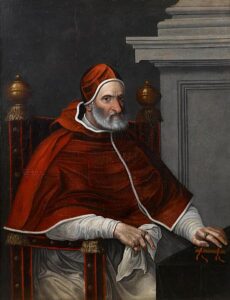
Portrait of Pope Pius IV, Bishop of Rome - The Council of Trent's decisions, decrees, and canons served as the model for the Catholic Counter Reformation, which restored the Church's dominance by providing clear guidelines, guidelines, and denitions of what it meant to be Catholic.
- Essentially, the Council corrected any abuses and policy mistakes while upholding all of the traditions and practices of the medieval Church.
- After addressing these issues, the Council confirmed the Church's supremacy as the only source of the Christian ideal. The Council of Trent's decisions continued to influence Catholic doctrine and practice until the 1960s and, to some extent, still do so today, despite the suspension of certain decrees, such as the Index.
Fast Facts
OBJECTIVES OF THE COUNCIL OF TRENT:
- To uphold the teachings of the Catholic Church and to oppose the beliefs and practices of Protestantism.
- To alter the elements of the church and the leaders' behavior that harmed the Catholic Church's ideas and reputation.
RESULTS:
- The Bible was to be interpreted exclusively by the church. Anyone who disagreed with the interpretation of Christianity was a heretic. Furthermore, both the Bible and Church Tradition were equally authoritative.
- Following conflicts over Martin Luther's teaching of "justification by faith alone," the link between faith and actions in salvation was established.

